Some of Taiwan’s prehistoric peoples buried their dead facing the sea, while others had their heads orientated towards the mountains. Some lay the dead on their backs looking skywards, others on their fronts, presumably staring eternally into the dark earth.
These different practices can no doubt tell us something about the views these ancient cultures held about life, death and the hereafter.
“Yes,” says Kuo Su-chiu (郭素秋), associate research fellow at Academia Sinica’s Institute of History and Philology, who has participated in numerous archaeological digs over the last three decades, “but what that is, is far from clear.
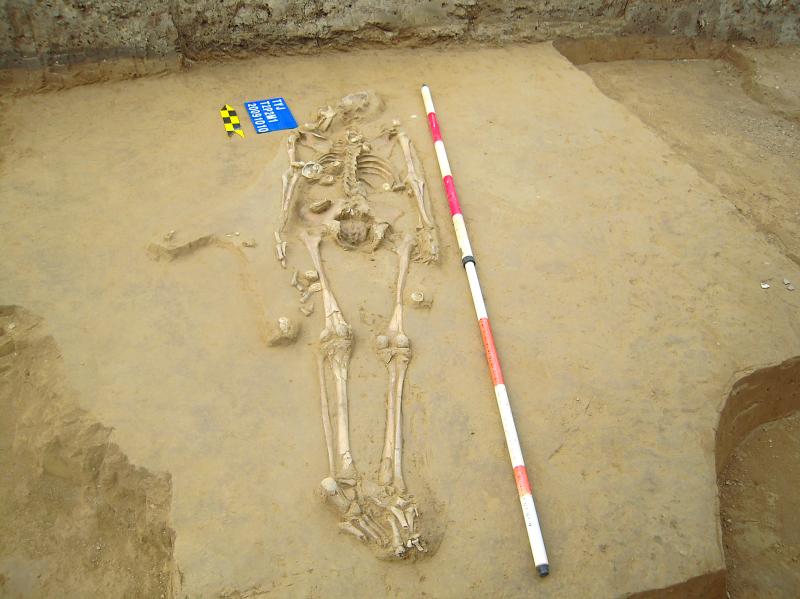
Photo courtesy of Kuo Su-chiu
“What is clear, is that each archaeological culture — many of which are ancestral to the twenty or more Aboriginal ethnicities of the modern era — had specific funeral customs that are as useful in identifying lines of inheritance and movements of people as are their potteries, stone tools and other material artifacts.”
She cites the example of the Shihsanhang (十 三行) site in New Taipei City’s Bali District, where beginning in 1990 around 300 skeletons were unearthed, dating from 1,800 to 600 years ago.
“All the skeletons were buried in a fetal position: on their sides with their limbs bent. Except one, an adult female, who was buried on her front and with her head turned to one side, which is typical of the contemporaneous Fantsuyuan (番仔園) Culture of central western Taiwan,” Kuo says.
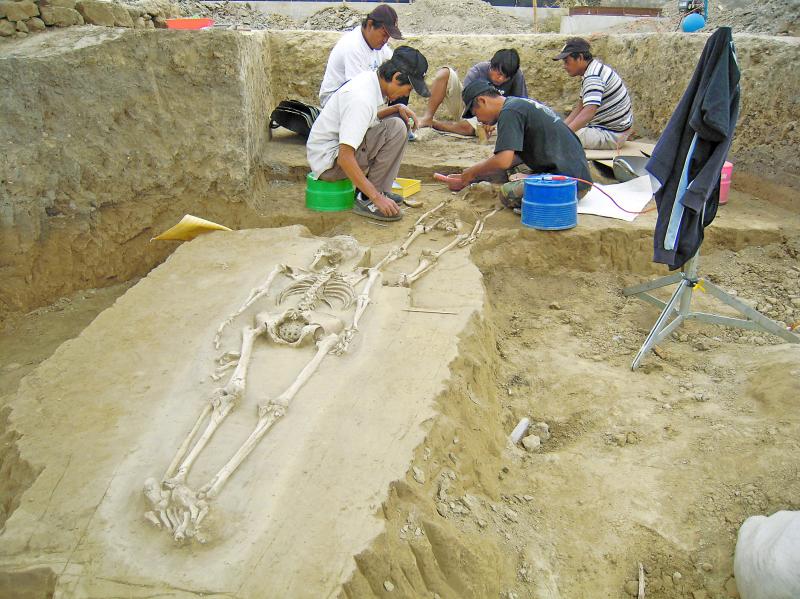
Photo courtesy of Kuo Su-chiu
From this, Kuo surmises the woman possibly originated from 200km to the south and may have died shortly after her inter-tribal marriage, indicating positive interactions between the two peoples rather than, or in addition to, competition or warfare.
UNEARTHED
Three Fantsuyuan corpses unearthed in 2009 by Kuo’s team at the Caiyuanjiao (菜園角) site on the Changhua Plain all had their heads turned to face north-northeast, though whether this was to “view” the sunrise, a mountain of spiritual importance, a landmark to help spirits find their way home or some other reason, would only be speculation, she says. Similarly, skeletons facing out to sea might be keeping watch over fellow tribespeople while fishing or could be honoring the direction from which their ancestors arrived in Taiwan.
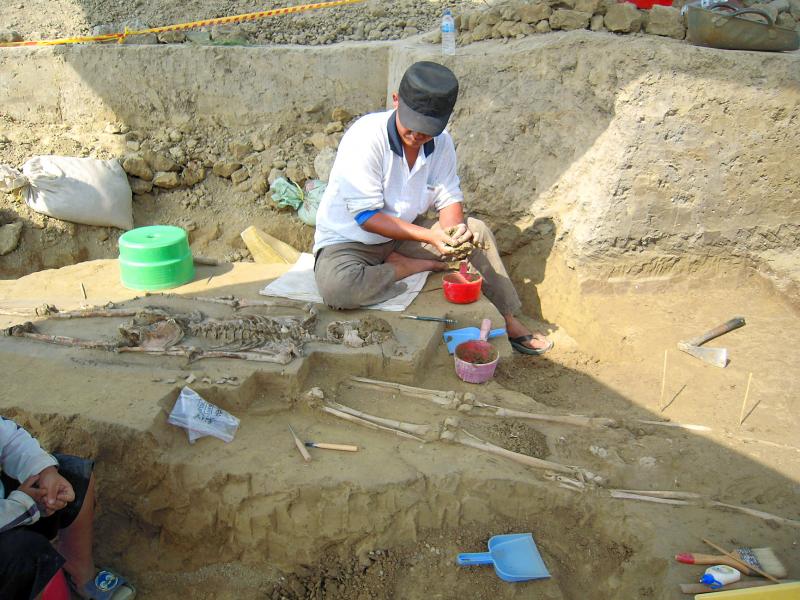
.Photo courtesy of Kuo Su-chiu
“It seems pretty clear that prehistoric peoples believed spirits inhabited the same space as the living, which is similar to the views of indigenous peoples in the modern era. Bad things could result from the bad moods of these spirits, so shamans performed ceremonies to interpret and placate them,” Kuo says.
Kuo adds that perhaps it is for this reason that corpses are buried close to homes at Caiyuanjiao, or sometimes actually inside the homes, such as in the Paiwan (排灣) Culture of southern Taiwan. In earlier times, she says, these latter were laid in a fetal position within a square slate coffin, but later on they were buried in a squatting position, with their heads just below the floor surface, so that they were as close as possible to tribespeople’s everyday activities.
The reason for this change is not known, but Kuo suggests it might be that, after repeated burials over several generations, they were simply running out of space. “Either way, it is clear they wished to keep their dead close to hand. Only people who died ‘unnaturally,’ such as by accident or suicide, were buried outside the community.”
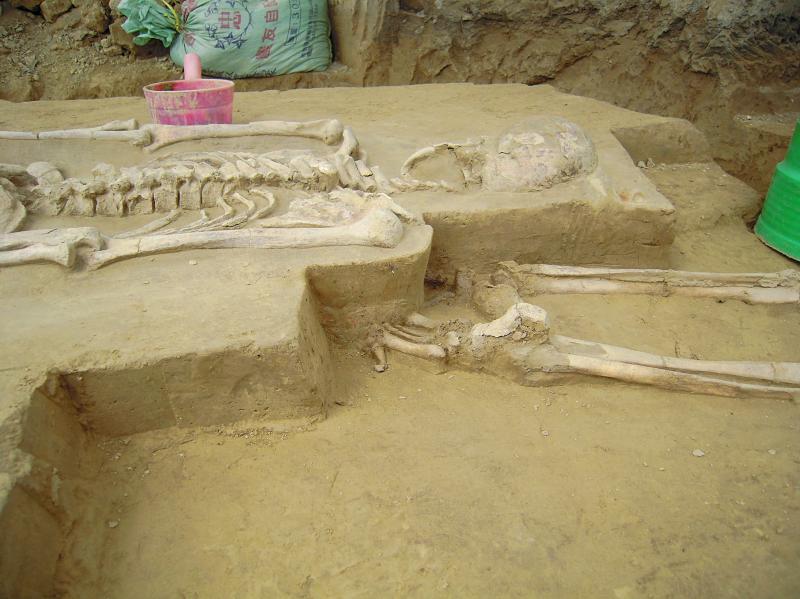
Photo courtesy of Kuo Su-chiu
The Fantsuyuan did not use coffins and merely buried their dead within the middens of discarded clam shells, broken pottery and other kitchen waste, while their southern neighbors, the Favorlang (華武壟), did not even cover corpses with earth, according to notes for a 17th-century Dutch colonial ‘Favorlang Dictionary.’
Kuo found corroborating evidence on her digs indicating shallow pits had been dug but, since even closely arranged skeletons did not interfere with each other, it suggested that earlier placements must have been evident.
While most gravesites are empty as bones decay quite easily, occasionally skeletons are found almost intact, which can provide a wealth of details. In addition to identifying the height, age and gender, Kuo calls on specialists to interpret such things as injuries, nutritional deficiencies and cause of death, and even something as abstruse as which leg a person favored when squatting.
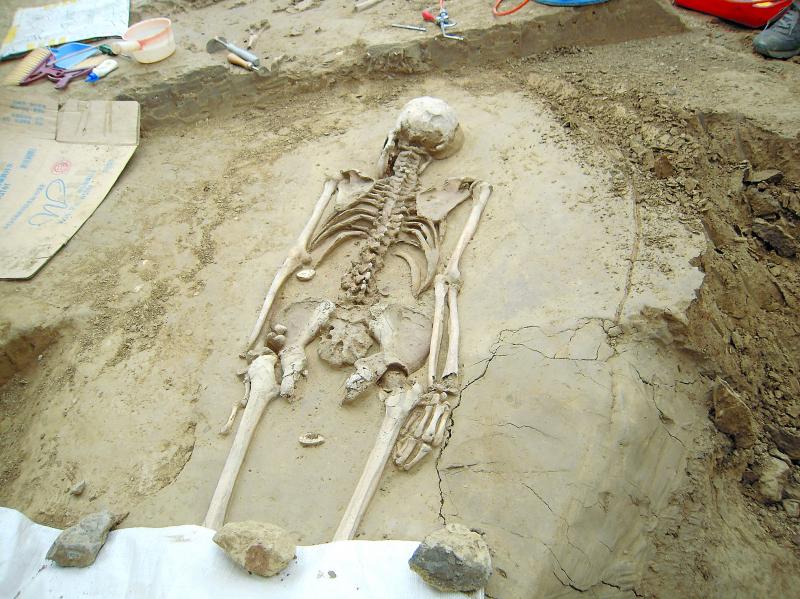
Photo courtesy of Kuo Su-chiu
“‘Empty’ is not the right word,” continues Kuo, “for while they might not contain bones which decay rapidly, graves may still contain funerary items buried with the dead. These can tell us a lot about the living, because the dead don’t bury themselves. And when objects are buried with them, they are taken out of circulation and no longer passed down to subsequent generations.”
TRADING NETWORKS
These funerary objects include glass, agate and shell beads, stone and metal tools, and local pottery as well as ceramics from China, Vietnam and Thailand, and bronze and silver coins from China, Japan and Mexico.
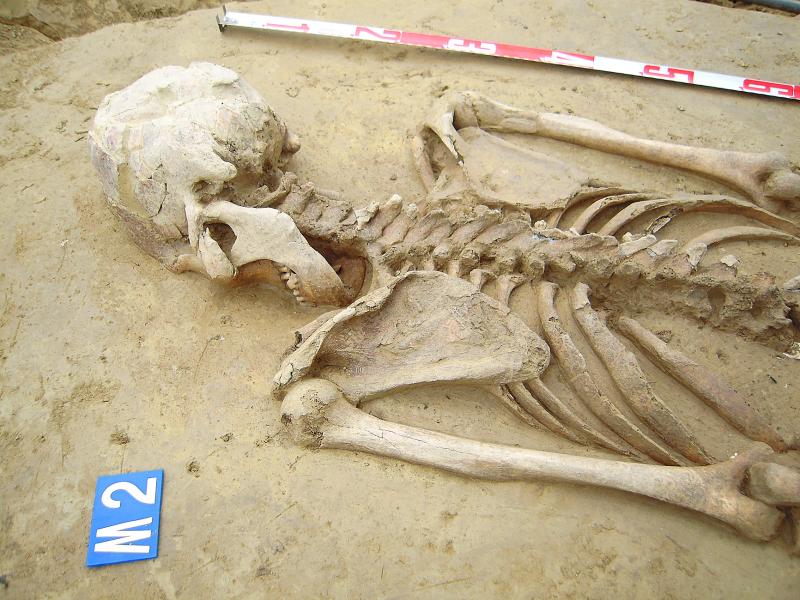
Photo courtesy of Kuo Su-chiu
As well as evidencing the vast networks of trade spanning firstly the South China Sea and later the globe, and helping to date individual sites, they also provide important data about economic conditions and social structures.
“Almost everyone buried at Shihsanhang, even the smallest child, was accompanied by funerary items. Some of these, like the human-figure nephrite earrings, would have been extremely valuable. This shows how rich the entire community was, due to their knowledge and practice of bloomery iron smelting.”
While pieces of iron have been found throughout Taiwan, they would have been obtained through trade, and Shihsanhang was one of only two communities in Taiwan which possessed the ability to smelt iron.
“In comparison, of the three skeletons at Caiyuanjiao, only one had three shell beads. These would have expressed the comparative wealth and status of the deceased,” says Kuo. “In southern Taiwan in the same period, men of the Niaosong (蔦松) Culture were often found buried with net sinkers and pointed bone or antler tools used for fishing and hunting, while many women were buried with spindle whorls used in weaving.”
“So although we still don’t know why some corpses are buried facing the ocean and others the mountains, whenever we excavate we learn something new about the ancient peoples and their ways of life,” concludes Kuo.

April 14 to April 20 In March 1947, Sising Katadrepan urged the government to drop the “high mountain people” (高山族) designation for Indigenous Taiwanese and refer to them as “Taiwan people” (台灣族). He considered the term derogatory, arguing that it made them sound like animals. The Taiwan Provincial Government agreed to stop using the term, stating that Indigenous Taiwanese suffered all sorts of discrimination and oppression under the Japanese and were forced to live in the mountains as outsiders to society. Now, under the new regime, they would be seen as equals, thus they should be henceforth

Last week, the the National Immigration Agency (NIA) told the legislature that more than 10,000 naturalized Taiwanese citizens from the People’s Republic of China (PRC) risked having their citizenship revoked if they failed to provide proof that they had renounced their Chinese household registration within the next three months. Renunciation is required under the Act Governing Relations Between the People of the Taiwan Area and the Mainland Area (臺灣地區與大陸地區人民關係條例), as amended in 2004, though it was only a legal requirement after 2000. Prior to that, it had been only an administrative requirement since the Nationality Act (國籍法) was established in

With over 100 works on display, this is Louise Bourgeois’ first solo show in Taiwan. Visitors are invited to traverse her world of love and hate, vengeance and acceptance, trauma and reconciliation. Dominating the entrance, the nine-foot-tall Crouching Spider (2003) greets visitors. The creature looms behind the glass facade, symbolic protector and gatekeeper to the intimate journey ahead. Bourgeois, best known for her giant spider sculptures, is one of the most influential artist of the twentieth century. Blending vulnerability and defiance through themes of sexuality, trauma and identity, her work reshaped the landscape of contemporary art with fearless honesty. “People are influenced by

The remains of this Japanese-era trail designed to protect the camphor industry make for a scenic day-hike, a fascinating overnight hike or a challenging multi-day adventure Maolin District (茂林) in Kaohsiung is well known for beautiful roadside scenery, waterfalls, the annual butterfly migration and indigenous culture. A lesser known but worthwhile destination here lies along the very top of the valley: the Liugui Security Path (六龜警備道). This relic of the Japanese era once isolated the Maolin valley from the outside world but now serves to draw tourists in. The path originally ran for about 50km, but not all of this trail is still easily walkable. The nicest section for a simple day hike is the heavily trafficked southern section above Maolin and Wanshan (萬山) villages. Remains of